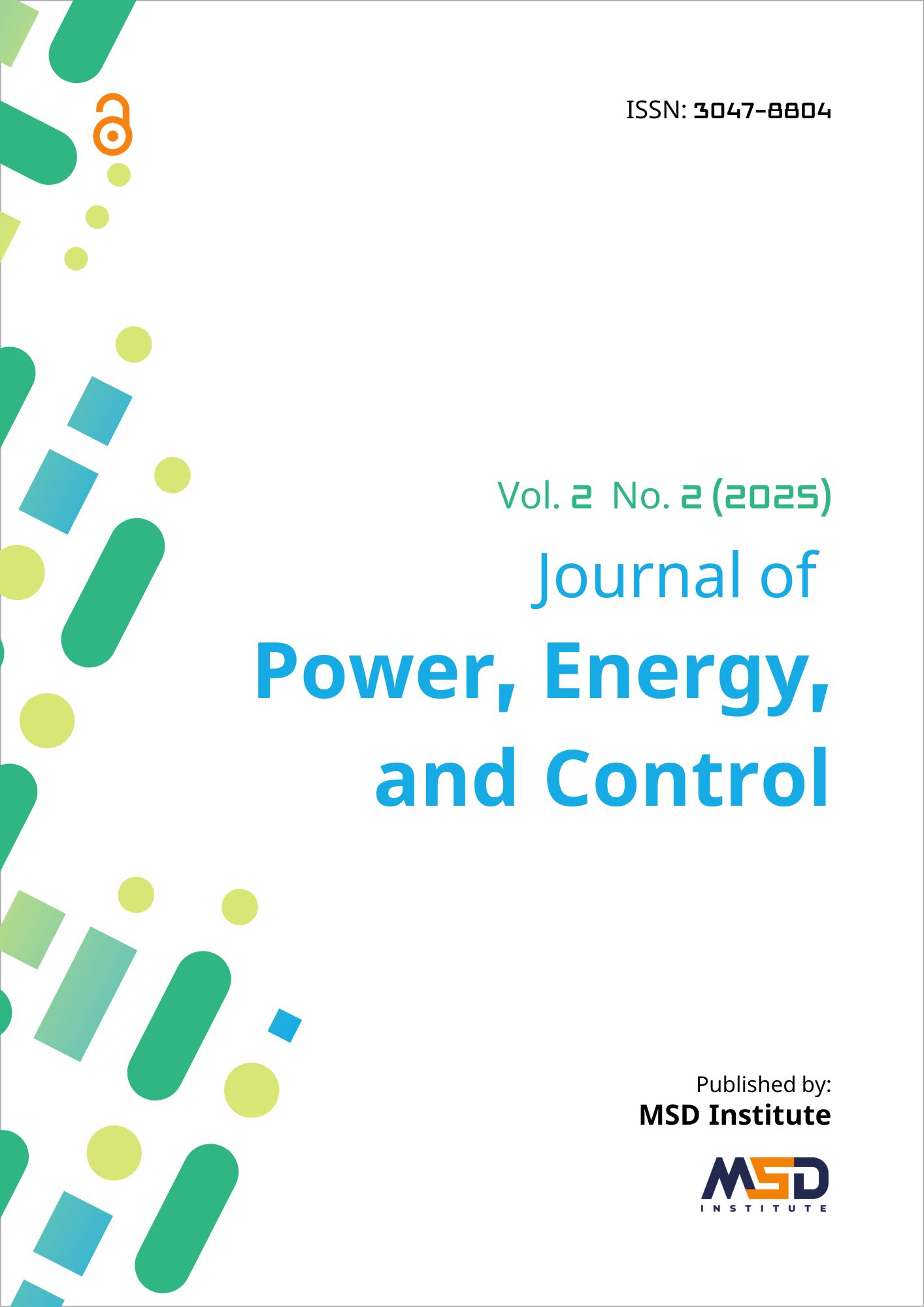Security Constrained Optimal Power Flow on A 132 kV Line with Service Potential Transformer Substations: A Case Study of Juja-Rabai Line
Published 21-09-2025
Keywords
- Security Constrained,
- Optimal Power Flow,
- Transmission line,
- Service Potential Transformer Substation,
- Kenya
Copyright (c) 2025 Joel Kitheka (Author)

This work is licensed under a Creative Commons Attribution 4.0 International License.
How to Cite
Abstract
The frequent power outages in transmission lines have been associated with generation station expansion to meet growing power demand without corresponding transmission infrastructure development, leading to exceeded loadability limits and system outages. This paper utilized PowerWorld simulator and a modeled Juja-Rabai power network to analyze secure optimal power flow conditions of a 132 kV transmission line with installed Service Potential Transformer (SPT) substations that address power demand from scattered villages near high voltage lines. The study focused on economic load dispatch of three thermal power plants (Thika, Rabai, and Kipevu) supplying power via conventional and non-conventional substations. Security constrained economic load dispatch, optimal power flow, and security constrained optimal power flow were analyzed under both pre-contingency and post-contingency states, including forced contingency scenarios. The results revealed that generating stations successfully adjusted their economic dispatch to achieve secure and economical operation, eliminating line outage risks. The analysis demonstrated that up to nine SPT substations can be optimally terminated on a 132 kV line while maintaining voltage stability and system security. The SCOPF methodology effectively balanced economic optimization with security requirements, providing a robust framework for transmission system planning in developing countries and supporting the viability of SPT technology for rural electrification.
References
- C. C. Anierobi, O. A. Ezechukwu, S. O. Ezennaya, V. A. Akpe, and J. V. C. Aghara, “Optimal Power Flow with Security Constraint for 330kv Nigeria Power Network using Power World Simulator,” International Journal of Engineering and Management Research, vol. 5, no. 4, pp. 497–503, Aug. 2015.
- F. Capitanescu, M. Glavic, D. Ernst, and L. Wehenkel, “Applications of security-constrained optimal power flows,” in Modern Electric Power Systems Symposium (MEPS06), Wroclaw, Sep. 2006.
- O. Mogaka, R. Orenge, and J. Ndirangu, “Static Voltage Stability Assessment of the Kenyan Power Network,” Journal of Electrical and Computer Engineering, vol. 2021, pp. 1–16, Feb. 2021, doi: 10.1155/2021/5079607.
- M. Moner-Girona et al., “Decentralized rural electrification in Kenya: Speeding up universal energy access,” Energy for Sustainable Development, vol. 52, pp. 128–146, Oct. 2019, doi: 10.1016/j.esd.2019.07.009.
- H. J. S. Sungu, “Analysis of the network performance and development of electricity transmission,” The University of Nairobi, Nairobi, 2021.
- S. A. Oketch, “Static voltage stability assessment of Nairobi area power distribution network,” Jomo Kenyatta University of Agriculture and Technology, 2015.
- M. J. Saulo, “Penetration level of un-conventional rural electrification technologies on power networks,” University of Cape Town, 2014.
- R. G. Gomez, A. S. Solano, and E. A. Acosta, “Rural electrification project development, using auxiliary service voltage transformers. Location of Tubares, Chihuahua, Mexico,” 2010, Calgary.
- D. Xu, N. S. Powers, and W. Sae-Kok, “Development of a power source for rural electriciation,” in 2015 IEEE Global Humanitarian Technology Conference (GHTC), IEEE, Oct. 2015, pp. 340–347. doi: 10.1109/GHTC.2015.7343994.
- D. A. Wallace, “ Development of method for providing simultaneous metering accuracy and power output from a dual secondary station service voltage transformer,” Mississippi State University, 2020.
- J. M. Kitheka, “The penetration level of ASVT substation on a power network for rural electrification,” in Kabarak University 5th Annual International Conference, 2015.
- J. M. Kitheka, “Determination of the maximum penetration level of Auxiliary Service Voltage Transformer Sub-stations on 132kV Transmission Network,” Jomo Kenyatta University of Agriculture and Technology, 2017.
- K. Nithiyananthan, R. Sundar, G. Tamilselvan, L. SathishKumar, and M. SaravanaPrabu, “Economic load dispatch estimation for a three phase power system network in cloud computing environment,” International Journal of Pure and Applied Mathematics, vol. 118, no. 20, pp. 1291–1298, 2018.
- M. Suman, M. V. Gopala Rao, A. Hanumaiah, and K. Rajesh, “Solution of Economic Load Dispatch problem in Power System using Lambda Iteration and Back Propagation Neural Network Methods,” International Journal on Electrical Engineering and Informatics, vol. 8, no. 2, pp. 347–355, Jun. 2016, doi: 10.15676/ijeei.2016.8.2.8.
- E. Obio et al., “Comparison of Economic Dispatch, OPF and Security Constrained-OPF in Power System Studies RN,” Journal of Power and Energy Engineering, vol. 10, no. 8, pp. 54–74, 2022.
- M. M. Bhaskar, M. Srinivas, and S. Maheswarapu, “Security Constraint Optimal Power Flow (SCOPF) - A Comprehensive Survey,” Global Journal of Technology & Optimization, vol. 2, pp. 11–19, 2011.
- H. Harsan, N. Hadjsaid, and P. Pruvot, “Cyclic security analysis for security constrained optimal power flow,” IEEE Transactions on Power Systems, vol. 12, no. 2, pp. 948–953, May 1997, doi: 10.1109/59.589787.
- F. Zaoui and S. Fliscounakis, “A Direct Approach for the Security Constrained,” in 2006 IEEE PES Power Systems Conference and Exposition, IEEE, 2006, pp. 1562–1569. doi: 10.1109/PSCE.2006.296146.
- L. Platbrood, H. Crisciu, F. Capitanescu, and L. Wehenkel, “Solving very large-scale security-constrained optimal power flow problems by combining iterative contingency selection and network compression,” in PSCC, Stockholm, 2011.
- F. Zhang, “Solving Large Security-Constrained Optimal Power Flow for Power Grid Planning and Operations,” Case Western Reserve University, 2020.
- A. Saghafinia, MATLAB - Professional Applications in Power System. InTech, 2018. doi: 10.5772/intechopen.68720.
- H. Saadat, Power System Analysis. McGraw-Hill, 2009.
- A. B. M. Nasiruzzaman, “A Student Friendly Toolbox for Power System Analysis Using MATLAB,” in Matlab - Modelling, Programming and Simulations, E. P. Leite, Ed., InTech, 2010, ch. 4, pp. 67–86.
- J. D. Glover and M. S. Sarma, Power System Analysis and Design, 3rd edition. Brooks/Cole Publishing, 2002.
- K. Kumar and G. Sasikumar, “Security Constrained Optimal Power Flow Using Benders Cut Principle,” International Journal of Control Theory and Applications, vol. 8, no. 1, pp. 264–276, 2015.
